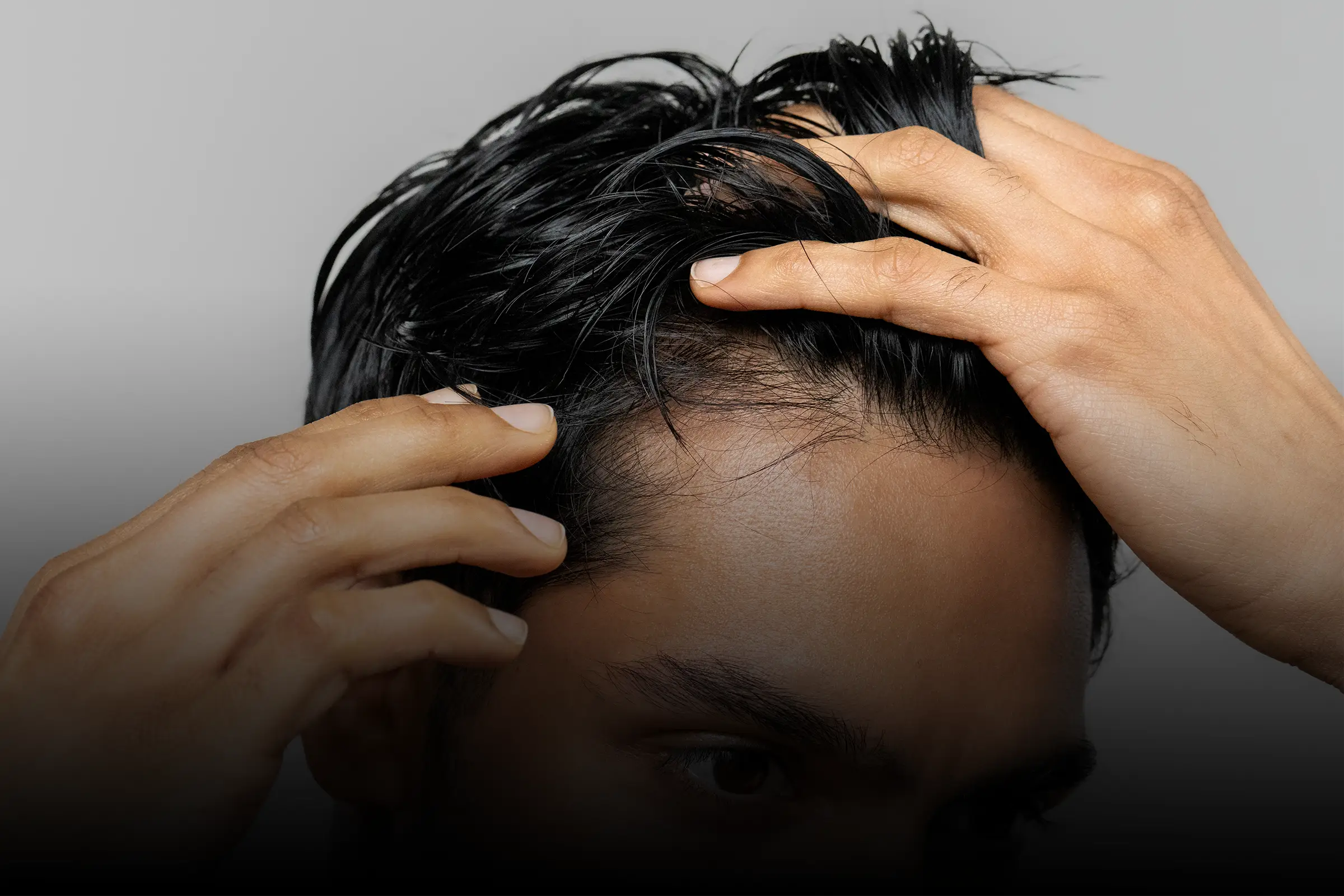One of the striking things about male pattern hair loss is how it seems to run in families. Sons of affected fathers notice that dad is starting to lose his hair and wonder if the same thing might happen to them. While science hasn’t quite nailed down how hair loss is inherited, there has been significant progress in determining what the most likely genetic culprits are. In this article, we’ll discuss whether there’s a baldness gene, how you can predict whether you’ll lose your hair and what you can do about it.
What is male pattern baldness?
Let’s do a quick recap. Male pattern baldness (androgenetic alopecia) is the most common type of hair loss in men, affecting approximately 50% of males by the age of 50. It’s a progressive disorder that involves the loss of terminal hairs on the scalp in a characteristic pattern involving the crown or vertex of the scalp (top of the head) and frontal scalp, or hairline.
Dihydrotestosterone (DHT) is the male sex steroid hormone that triggers the development of male pattern baldness, but DHT levels alone are not sufficient to cause balding. Research has shown that in most cases, it’s the interaction between hormonal factors and genetic predisposition that determines whether someone will go bald.
Get ahead of hair loss with our performance solutions and team of hair loss experts.


Balding doesn't have to be inevitable.
Is there a male pattern baldness gene?
It’s unlikely that male pattern baldness can be traced back to a single gene. Scientists have attempted to locate and identify one, but it seems more likely that the condition is the sum of contributions from many gene variations. This concept is known as polygenic inheritance.
One of the ways in which male pattern baldness has been studied is through genome wide association studies, or GWAS. These studies test large populations of individuals who share ancestry but display different characteristics (otherwise known as phenotypes) to determine which gene variations are the most statistically significant to a condition. This data can help reveal information about how a disorder develops, as well as its heritability (Uffelman et al., 2021).
One large GWAS of 40,000 subjects in the UK found 287 different regions (or loci) of the genome that were found to have possible effects on the development of hair loss (Haagenars et al., 2017). 40 of these loci were located on the X chromosome, which is also where the androgen receptor gene is found. Remember, the androgen receptor gene influences how the body responds to androgens such as DHT. So gene variations in this region have a direct effect on DHT levels and metabolism. Research has also shown that variations in the regions of the X chromosome that flank each side of the androgen receptor gene (‘upstream’ and ‘downstream’ genes called EDA2R and OPHN1) may also affect whether an individual develops androgenetic hair loss.
Another study of over 200,000 individuals identified more than 600 loci associated with early onset hair loss (Yap et al., 2018). It’s not known if these loci are causally related or how exactly these genetic variations contribute to the progressive hair loss. What we do know is that many of these genes play roles in hair growth and development (e.g. producing proteins involved in cell signaling and structural proteins).
How is balding inherited? Where does the bald gene come from?
Whether hair loss comes from the father’s or mother’s side of the family is a hotly debated topic. It’s a common misconception that balding comes from the mother’s side of the family. As mentioned above, baldness is inherited as a polygenic trait, meaning multiple gene variations are involved that can come from either side of the family. The androgen receptor gene itself is located on the X-chromosome, which means that variations in this gene are inherited from the maternal line. But we now know that there are many other autosomal (non sex chromosome related) loci that contribute to the heritability of balding. These autosomal loci can come from your mother or father.
How to tell if you will go bald
There’s no definitive way of telling whether you’ll lose your hair. But there are two big signs to watch out for that could indicate an increased risk for hair loss:
- Your family history
- Looking out for early signs of balding
Family history is key and genetics likely accounts for a high percentage of cases of male pattern baldness. One large scale study of 900 monozygotic (identical) and dizygotic (non-identical) twins between the ages of 25 and 26 found the heritability of pattern hair loss to be 0.81. This is a significant finding that suggests that approximately 80% of the hair loss in this population can be explained by genetics (Heath et al., 2003).
But what if you don’t have a twin? Are there other predictors of hair loss? Research has shown that just having a first degree relative such as your father lose his hair can make it 5-6 times more likely that you’ll lose your hair (Ho et al., 2022). What’s more, one Australian study of fifty-four father-son pairs found that 81.5% of balding sons had fathers who experienced cosmetically significant balding themselves (Ellis et al., 1998). So, whether dad still has his hair could be one useful predictor.
You can also watch out for the early signs of balding. These signs can include:
-
Thinning of the frontal hairline, temples and/or top of the head
These regions are the most likely to be affected in male pattern hair loss. Thinning in these areas can creep up on you and is typically most noticeable when cleansing or styling your hair.
- Changes in hair texture and/or hair colourIn addition to thinning hair, some men with a predisposition to balding may also notice changes in hair texture and colour. The effects of DHT include changes to the shape of hair follicles (which affects texture) as well as the abnormal development and distribution of pigment cells (responsible for hair colour).
-
Increased scalp itchiness or oiliness
These may be indicators of small-scale inflammation (i.e. microinflammation) occurring within hair follicles, which some clinicians consider a contributing factor to partner hair loss.
It’s not always possible to predict the rate of hair loss and in some cases, thinning can happen quickly. If you believe that you might be at risk of losing your hair, early prevention is key. You can start by talking to your doctor about hair loss and discussing your treatment options.
Is there any way to prevent balding?
While you may not be able to completely prevent pattern hair loss, there are ways to slow down its progression and improve the overall look of your hair. The main thing to remember is that successful treatment needs to start early.
Firstly, there are healthy habits that you can adopt to help get you on the right track to keeping your hair. These include getting enough sleep, exercising, keeping the scalp clean with a quality shampoo and conditioner (such as XYON's DHT-Blocking Shampoo) and maintaining a balanced diet. These measures are important in setting the foundation for hair regrowth.
Secondly, if your hair has already started to thin, treatment with a medication such as finasteride or minoxidil may be needed to prevent it from worsening. These medications target different causes of hair loss, so it’s important to discuss these differences and whether they’ll meet your needs with a doctor. Many men don’t realize that they can do something about hair loss or assume that because genetics play a role, that they should just accept it. This does not have to be the case. In fact, identical twin studies have shown that if one twin treats their hair loss early while the other does not, the treated twin goes on to maintain their hair compared to the untreated twin (Stough, 2007).
Male pattern baldness gene: Takeaway
Genetics play an important role in the development of male pattern hair loss and we’ve learned that the heritability of balding isn’t just due to variations in the androgen receptor gene. While the androgen receptor gene is responsible for the body’s response to DHT, there are also contributions from other genes that produce proteins that influence cell growth more generally. If you’ve noticed some early signs of balding and also have a family history of hair loss, remember that there’s still time to do something about it. We recommend connecting with a doctor in your community or starting a consultation through the XYON Health platform to talk about your hair loss and determine what the next steps should be to stop it in its tracks.

























